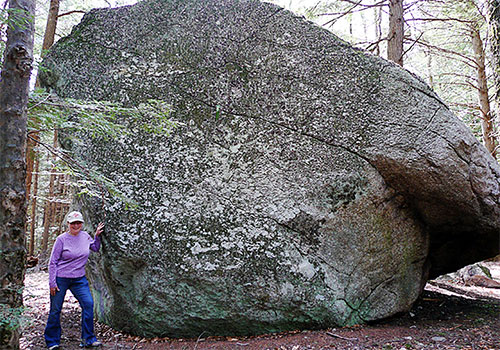Geology of Wilder Rock

by Lee Wilder
This large rock is a glacial boulder. It was dropped here out of the melting ice of the last glacial advance. The ice of that ice age (AKA the Pleistocene) had advanced as far south as Long Island, NY here in eastern North America. As the climate began to naturally warm, some 20,000 years ago, it began melting the huge ice sheet’s margins. The ice had melted back to south central NH by some 12,000 years ago. All the soil and rock that the advancing ice had picked up, was left sitting on the land surface as the ice melted. The Pleistocene ice generally flowed from northwest to southeast across New Hampshire.
Click here see those “flow marks’ in a LiDAR map of the Hopkinton Area.
Click here for instructions on accessing a view of the “flow marks” in the LiDAR map.
Wilder Rock is just one of several large boulders that the melting ice left in Hopkinton, NH. Another of interest, located on public land, is the “Sharpe’s Farm Boulder” located on Army Corp of Engineering land, west of Old Bassett Mill Road and south of the dike at the Cressy Brook Recreation Area in west Hopkinton – GPS N 43 11.400 W 071 42.353. See map at: https://www.nae.usace.army.mil/Portals/74/docs/Recreation/HEL/HopkintonLakeMap.pdf.
The melting Pleistocene ice left lots of boulders. But few remain. Early settlers found them a ready source of building stone without having to open a bedrock quarry. (Think of Swenson’s Quarry on Rattlesnake Hill in Concord, NH.) If the boulders were fine grained granites, they could be cut into building blocks with the use of stone drills and wedges. These stone blocks were used as foundation stone and door steps. The stone of St. Andrew’s Church in Hopkinton Village is from such a source.
But if the boulders were composed of large mineral grains, they did not split easily into nice workable construction pieces. If you look closely at the mineral makeup of Wilder Rock, you will see that it has large whitish mineral grains. These 1 to 2-inch rectangular shape minerals are Feldspar. They are an easy way to identify this rock as the Kinsman Granite. Kinsman Granite does not cut well, thus most Kinsman boulders “escaped” being cut up into early construction stone.
The soil the melting ice left, sits on the rock of the Earth’s crust. Crustal rock under the soil is called the bedrock. Looking around the rise upon which Wilder Rock sits, you don’t find Kinsman Granite as the bedrock. Glacial boulders that differ from the bedrock upon which they now sit, geologists call a glacial erratic. Being of a different rock type, it is proof that the boulders were transported to their present location. So geologically speaking, Wilder Rock is a large glacial erratic of Kinsman Granite. Visit the Sharp’s Farm Boulder and see what you think it is.
